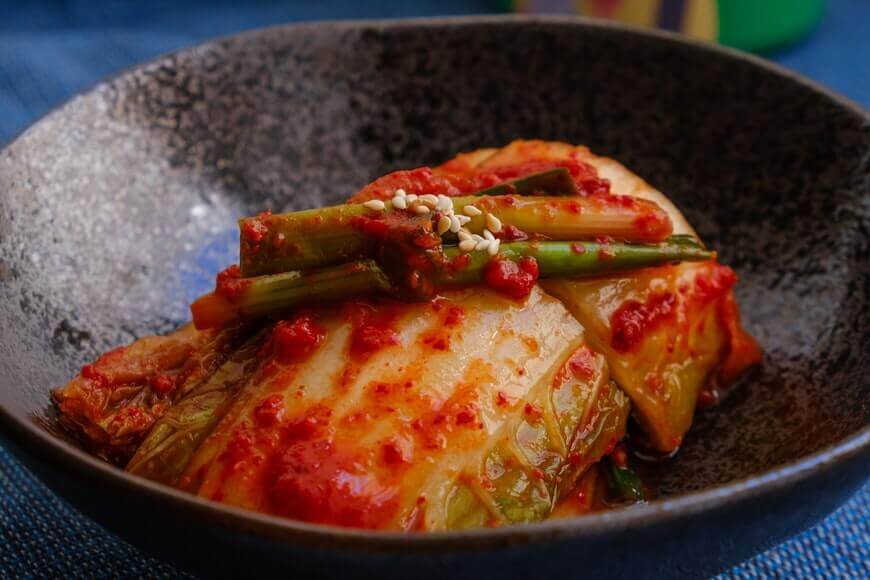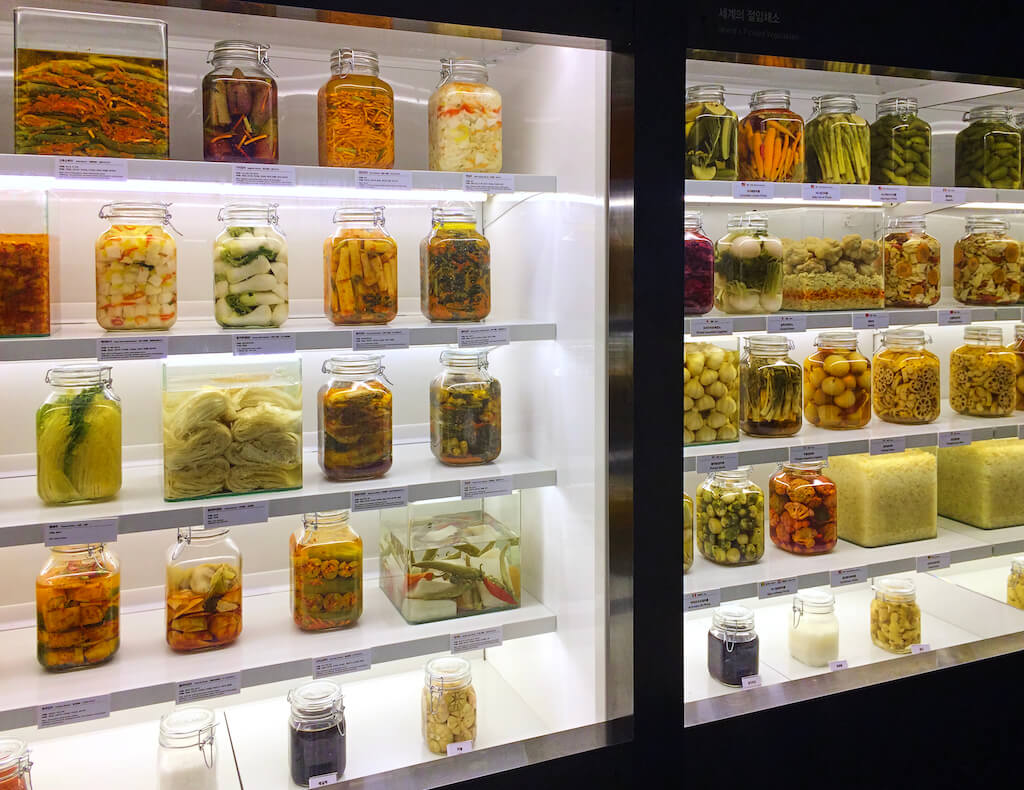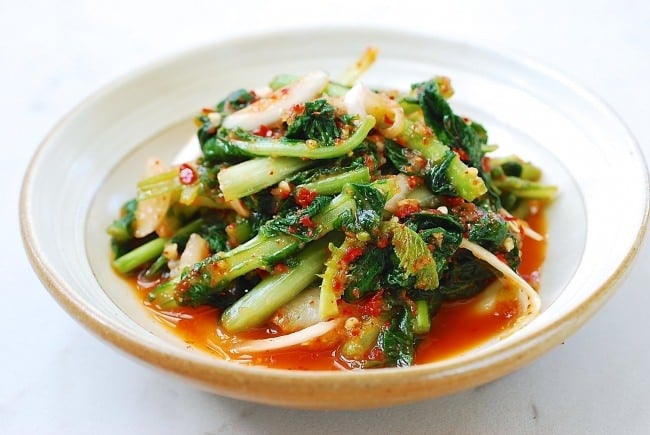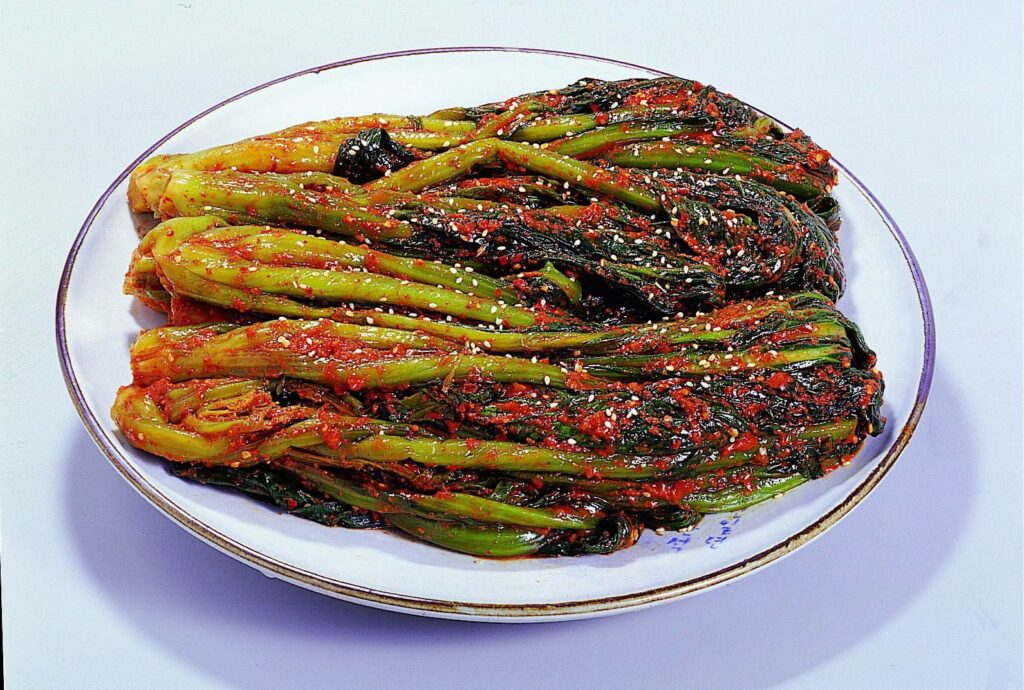Kimchi is one of the most popular Korean foods in the world and is distinguished by its spicy flavor, crispness, and pungent aroma. It is a sign of how effectively South Korea has used its pop culture and food as part of its branding and “soft power” strategy and that it is one of the things that Korea is known for.
There is a good possibility that you have eaten or at least heard about kimchi wherever you are in the world. Perhaps you ate it with your grilled cheese sandwich, a steaming bowl of ramyeon, or your Korean barbeque. But despite its widespread use, how much do we actually understand about it?

This collection of kimchi facts will dispel your misconception that this dish is simply a hot, funky-smelling cabbage salad. These kimchi facts will transport you on an exhilarating journey through kimchi’s vibrant past without the need for a time machine!
1. Kimchi has a long-standing history
Nobody is certain of the exact date that Koreans began creating kimchi. Onggi, a brown ceramic jar, was used to ferment vegetables, according to the Samguk Sagi, a history of the Three Kingdoms of Korea (57 BC – 668 AD).
Because there were no refrigerators in ancient Korea, pickling vegetables helped extend the shelf life of food. Furthermore, these pickled vegetables were allowed to mature in the jars and kept in the ground to avoid freezing because Korea has historically experienced long, hard winters.
According to legend, the spread of Buddhism during the Silla era (57 BC–935 AD) led to kimchi being more popular throughout the country. In Goryeo, the radish kimchi also spread like wildfire (918–1392).
2. And it wasn’t always spicy
The typical kimchi most of us are familiar with is fiery red. However, did you know that it wasn’t always spicy?
The earliest varieties of kimchi were just brine- or soybean-fermented vegetables, primarily radishes. The introduction of chili peppers, which were not indigenous to Korea, began in the early 17th century thanks to Portuguese traders.
The peaceful village of Cheongyang is now renowned for producing the hot “Cheongyang pepper,” one of the nation’s most popular peppers. It has a Scoville heat rating of 10,000 and is frequently pounded into a powder to be used in making kimchi and other dishes.
3. Kimchi was one of the official foods of the 1988 Olympics


Korean officials were concerned about how international athletes and journalists would respond to kimchi in the run-up to the 1988 Olympics, which Seoul hosted. They claimed that because of its flavor and strong aroma, kimchi alienated and turned away the majority of foreigners.
Though it is unimaginable today, there was a time when Koreans were worried about presenting kimchi to guests. Fortunately, a deal was reached.
Despite the fact that kimchi was one of the official cuisines of the 1988 Olympics, Korean staff members who were interacting with international guests were advised to clean their teeth properly after every meal.
The first time kimchi was served to a global audience was at the 1988 Olympics, where it was favorably received and many spectators developed a taste for it.
After the Olympics, sales skyrocketed locally and across the world.
4. There are over 200 types of kimchi
The fact that kimchi comes in a wide variety is one of my favorite kimchi facts. And by a lot, I mean a lot.
Even Koreans themselves haven’t sampled all of Korea’s variations because there are so many of them. The most well-known kimchi is the traditional baechu (napa cabbage), which is followed by ggakdugi (chopped radish), gat (mustard leaf), baek (white), nabak (mildly spicy radish water), and dongchimi (non-spicy radish water).
However, I bet you were unaware that more fruits and veggies are being used to make kimchi. You name everything, there’s definitely a kimchi version of it, from eggplant to spinach, persimmons, pineapple, oranges, bamboo shoots, pears, and grapes.
5. And not all of them are fermented
The fermentation used in the traditional method of creating kimchi is what gives it its distinctively sour flavor and potent aroma. However, there is a type of fresh, unfermented kimchi known as geotjeori. Yeolmu kimchi is another option; it’s produced from radishes and can either be fermented or not.
Fresh kimchi doesn’t undergo fermentation, so the vegetables are more tender and the flavor is more raw and salad-like. Furthermore, while a significant amount of salt is required to ferment kimchi, a minimal amount is used while making fresh kimchi. Unfermented kimchi also lacks probiotics for obvious reasons.
6. Baechu kimchi is the most popular type of kimchi


You are aware of this, though.
Baechu kimchi, also known as napa cabbage kimchi, is the most popular variety of kimchi both in Korea and internationally. It is so popular that it is frequently referred to as simply kimchi.
This style of kimchi is often made in the late fall or early winter. Before being fermented with different ingredients like jeotgal (salted fish), gochugaru (chili powder), and other flavors that vary by area or family, whole napa cabbage leaves are salted.
7. South Korea consumes nearly 80 pounds of kimchi per person per year
South Koreans devoured 40 pounds of kimchi per person on average in 2003. By 2017, it was estimated that South Koreans consumed 1.85 million metric tons of kimchi yearly, or an average of 36.1 kilograms (80 pounds) of kimchi per person. A few years later, this figure increased to 50 pounds.
Think about that.
8. There is an ongoing “kimchi war” between South Korea and China
Because Korean kimchi is a descendant of the Chinese cuisine pao cai, China has prohibited the import of kimchi since 2012.
New pao cai regulations were announced by the International Organization for Standardization (ISO) in November 2020. According to the Chinese news outlet Global News, these new ISO regulations serve as “an international standard for the kimchi sector led by China.”
It goes without saying that this infuriated South Koreans, and influencers from both nations fueled the fire. The kimchi conflicts got even worse in March 2021 after a video clip about “Kimchi manufacturing in China” went viral. A shirtless man was seen in the video sorting cabbages in a puddle of sludge-colored liquid.
The trend to avoid kimchi made in China as a result of this led to a decrease in imports.
9. Taking photos in Korea? Don’t say cheese, say kimchi!
Instead of saying “cheese” as is customary when taking pictures, many Koreans exclaim “kimchi!”
Many because, just as not all English-speaking people use the word “cheese,” not all Koreans use the word “kimchi.” Some people say “cheese,” “smile,” “whiskey,” “LG” (yep, the Korean electronics company), and other things as well. Simply said, any word that rhymes with cheese is acceptable in Korean.
Throw up the “peace” sign or the “finger heart” for the full Korean photo shoot!
10. A kimchi museum was named one of the world’s best food museums by CNN


The Kimchi Field Museum opened its doors in Pildong, Jung-gu, in 1986. It is a kimchi museum, as the name would imply. The first food museum in Korea was run by Pulmuone Inc., one of the country’s leading kimchi producers and brands.
It was relocated to Insadong in 2015 and reopened with the name Museum Kimchikan. It was chosen by CNN as one of the top culinary museums in the world that same year.
This exhibit serves as a good example of how seriously Koreans take their kimchi. You can sample many kimchi variations and even learn how to manufacture kimchi in addition to historical exhibitions on kimchi.
11. Kimchi has a chockful of nutrients and probiotics
Kimchi is nutrient-dense because it is primarily made of vegetables (or occasionally fruits). While the amount of nutrients in each type of kimchi varies, you can expect to find plenty of dietary fiber, vitamins A, B1, B2, B3, B6, C, and K, calcium, iron, and folate — nutrients that support energy production, bone health, and metabolism.
As a fermented food, kimchi is also rich in probiotics (lactobacilli) that improve gut health and immunity. What’s best? It has few calories!
12. Yeolmu kimchi and gat kimchi pack the highest vitamin content


In general, kimchi is healthy. Select yeolmu (young summer radish) and gat (Indian mustard) kimchi instead if you must choose between several types.
Yeolmu kimchi offers 3.3 grams of dietary fiber per 100 grams, the greatest amount of vitamin A among popular varieties at 595mcg, 0.29 mg of vitamin B2, and 28 mg of vitamin C.
The same amount of gat kimchi has 48mg of vitamin C, 4g of dietary fiber, 390mcg of vitamin A, and 1.3mg of niacin.
Nevertheless, these varieties of kimchi are less widespread outside of Korea.


13. Did You Know? Kimchi may aid in weight loss
Researchers discovered that consuming kimchi helped lower body weight, body fat, and blood sugar levels in a 4-week study on 22 overweight participants. The weight loss benefits of fresh and fermented types were similar. Those who had fermented kimchi, however, showed larger gains, including reduced blood sugar levels.
Although the particular ingredients in kimchi that cause these effects are unknown, fiber, vitamins, and probiotics may all play a role. It is also believed that the capsaicin in Korean red chili helps break down fat and speeds up metabolism.
14. But there are also side effects…
You should be able to eat as much kimchi as you want given the health benefits listed above, right?
Yes. Unless you suffer from IBS (irritable bowel syndrome) or are at high risk for heart disease, stroke, or high blood pressure.
We frequently overlook the fact that kimchi fermentation needs a lot of salt. Kimchi contains 1,232 mg of salt per serving. To put things in perspective, the average daily salt intake for Koreans is 4,553 milligrams, which is more than twice the 2,000 mg/day limit recommended by the World Health Organization.
Large amounts of garlic are also included in kimchi, which may make IBS sufferers react unfavorably.
Then, is kimchi unhealthy for you? No. You should be able to eat kimchi on a regular basis as long as you consume it in moderation and don’t have the aforementioned criteria.
15. Kimchi may last for years
Typical kimchi ferments for 2-3 weeks in the refrigerator or 3-4 days at room temperature. Kimchi only lasts a week when kept at room temperature after being opened.
It keeps fresh for about 3 to 6 months in the fridge, but as it continues to ferment, the sourness increases. However, I don’t know how you were able to keep a jar for so long.
It can go bad, but it’s hard to know when it does. What some people find offensive may not always find offensive to others. The ability to tolerate sourness might also vary from person to person. However, it’s time to discard your kimchi if you see any mold there.
